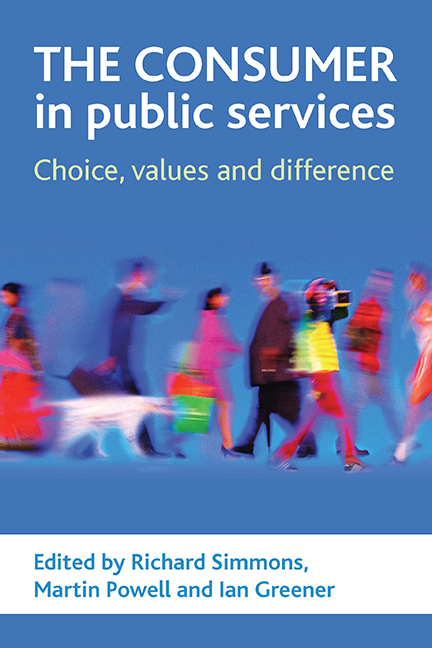Book contents
- Frontmatter
- Contents
- List of figures and tables
- Acknowledgements
- Notes on contributors
- Foreword
- one Introduction: managing the ‘unmanageable consumer’
- two The consumer and New Labour: the consumer as king?
- three Narratives of public service delivery in the UK: comparing central and local government
- four Understanding the ‘differentiated consumer’ in public services
- five Differentiating consumers in professional services: information, empowerment and the emergence of the fragmented consumer
- six The healthcare consumer
- seven The consumer in education
- eight The consumer and social housing
- nine The people’s police? Citizens, consumers and communities
- ten The consumer in social care
- eleven Differentiated consumers? A differentiated view from a service user perspective
- twelve Authoritative consumers or experts by experience? User groups in health and social care
- thirteen The public service consumer as member
- fourteen Conclusion: the consumer in public services
- Index
eight - The consumer and social housing
Published online by Cambridge University Press: 22 January 2022
- Frontmatter
- Contents
- List of figures and tables
- Acknowledgements
- Notes on contributors
- Foreword
- one Introduction: managing the ‘unmanageable consumer’
- two The consumer and New Labour: the consumer as king?
- three Narratives of public service delivery in the UK: comparing central and local government
- four Understanding the ‘differentiated consumer’ in public services
- five Differentiating consumers in professional services: information, empowerment and the emergence of the fragmented consumer
- six The healthcare consumer
- seven The consumer in education
- eight The consumer and social housing
- nine The people’s police? Citizens, consumers and communities
- ten The consumer in social care
- eleven Differentiated consumers? A differentiated view from a service user perspective
- twelve Authoritative consumers or experts by experience? User groups in health and social care
- thirteen The public service consumer as member
- fourteen Conclusion: the consumer in public services
- Index
Summary
Introduction
The position of social housing as a service that is slightly removed from other public services, the ‘wobbly pillar’ of the welfare state, is well known (Malpass, 2005). As Kemeny (2006) notes, housing is different because vested market interests have a stronger historical stake than they do in areas such as health and education. The role of the private consumer is not as strange to housing as it is to the worlds of education or health: most people in the UK choose their own housing in the market.
The relationship is further complicated by the nature of housing choices. Jordan (2006) states that welfare services have a temporal nature, as they are dependent on human relationships, while goods have a more permanent character. What is notable about housing as opposed to basic healthcare and education is that the service user is effectively choosing capital goods rather than services. Social landlords do provide many services for their tenants, but applicants have no definite way of knowing what level of service to expect. In this respect it is possible to claim that housing is the area that is most suited to choice-based mechanisms. Choosing a property is a decision based on tangible factors, whereas individuals choosing a service are reliant on information that they may not believe and opinion that they may not trust. While housing applicants are also reliant on experts and there is still a temporal aspect in that faults in a house become apparent over time, it is nevertheless the case that houses themselves provide grounding on which to base a decision. The extent to which that decision can be considered to be a genuinely empowered one is at the centre of issues of consumerism in social housing.
To be genuinely offered meaningful choices, tenants also have to be able to influence the services they are offered. Choices such as decoration, or appointment times, are likely to be dependent on individual circumstances and taste, and in recent times housing policy has emphasised the importance of responsive landlords. However, choices in social housing also vary between landlords, and the Cave Review (2007) has highlighted that more needs to be done to ensure that there is effective regulation. Moreover, social housing has a rich history of tenant activism influencing local authority decision making and, in some cases, national policy.
- Type
- Chapter
- Information
- The Consumer in Public ServicesChoice, Values and Difference, pp. 137 - 156Publisher: Bristol University PressPrint publication year: 2009

